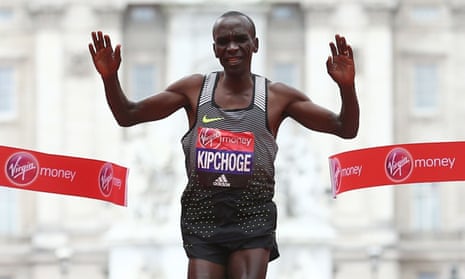Roll up, roll up – come and see the last of the “world marathon majors” before a man breaks the two-hour barrier.
This could be the pitch for Sunday’s London marathon when some 38,000 runners take to the capital’s streets in an event watched by millions. Many will be hoping for a race as memorable as last year when Kenyan Eliud Kipchoge ran a course record, coming home in 2:03:05.
But Kipchoge will not be competing this year. Instead, he is one of three Nike-sponsored runners who will next month seek to achieve what many had thought was impossible: run 26.2 miles in under 120 minutes.
The attempt will not take place at any of the world’s six renowned marathon courses – London, Boston, Berlin, Tokyo, New York and Chicago – collectively known as the majors. Rather, it will be run on a fixed 1.5-mile loop of the Monza racetrack outside Milan, a location specifically chosen as it has the optimum temperature, protection from the wind, and pancake-flat asphalt.
The run is being staged by Nike, which has poured vast amounts of money into the event and plans to stream it live.
Few experts think the barrier will be smashed, but many believe it could change the marathons of the future.
“If you go back to 2014 when Dennis Kimetto broke the record in Berlin [in a time of 2:02:57] they [the Monza runners] are going to have to finish two-thirds of a mile ahead of where he was when he crossed the line,” said John Brewer, professor of applied sport science at St Mary’s University, Twickenham, and author of the forthcoming book, Run Smart.
“That’s a huge distance. It’s very easy to say ‘oh it’s less than three minutes’, and for someone like me, running the marathon on Sunday in around four hours, three minutes is not that much, but for the pace that those guys are going at, it’s the equivalent of one second a lap in Formula One.”
A more realistic prospect is that one of the three breaks Kimetto’s record and is crowned the fastest man in the world over 26.2 miles. Either way, Nike wins.
“Even if the event is not an official marathon, everyone knows that the distance comes from the race, and so even if the record is not officially ratified, it will be known as the fastest ever marathon,” said Professor Martin Polley, director of the International Centre for Sports History and Culture at De Montfort University, Leicester, and author of The British Olympics. “The real challenge will come afterwards: if one of the Nike runners manages the incredible ‘sub-two’ at Monza, will he be able to repeat it on the streets of the next city marathon or at the Tokyo Olympics in 2020?”
Few think this would be possible because the conditions in a real marathon are so different, triggering accusations that Nike is attempting little more than a marketing gimmick.
But Ellis Cashmore, professor of sociology at Aston University, Birmingham, and author of Sports Culture, said the running world had benefited from specially created events in the past.
“Nowhere does it state you shouldn’t prearrange races in an explicit attempt to run records – or else Roger Bannister wouldn’t have run the first sub-four-minute mile,” said Cashmore, who suggested Nike was simply doing what all brands do: reach large audiences.
“Sport is now the most valuable advertising platform in history. Ask yourself next time you watch a marathon, a football match or an F1 race: am I watching sport, or am I being subjected to two or more hours of advertising? The competition we watch is superficial: the competition in earnest is brand vs brand.”
Indeed, marathons have been acutely aware of their commercial potential.
“Oxo provided the official refreshment for runners in the 1908 London Olympics marathon,” Polley said. “Commercial backers quickly staged rematches between the winner, Johnny Hayes, and the disqualified Dorando Pietri at Madison Square Garden and the Royal Albert Hall.”
The latter race took a stultifying 524 laps, which may explain why it never caught on. For similar reasons, Brewer thinks London has little to fear from Monza. “Watching them go round and round for two hours is not the most absorbing, whereas Sunday’s marathon has got real stories of real people.”

Comments (…)
Sign in or create your Guardian account to join the discussion